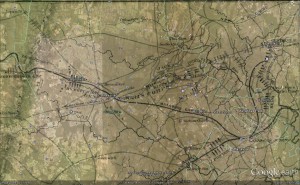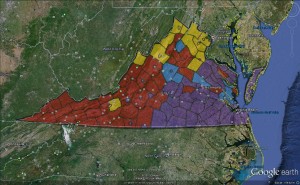People have debated for decades the precise role of slavery in precipitating that war. Some emphasize fundamental, irreconcilable conflict between societies based on forced labor and contract labor. Others emphasize instead contingent events in the political realm. Those who stress intrinsic conflict have often built their arguments around the general concept of modernization, with the North embodying the characteristics of modern society-democracy, economic innovation, and social mobility–and the South explicitly resisting those characteristics. Those who isolate political conflict, by contrast, tend to emphasize the fundamental similarities in ideology and culture of white Northerners and Southerners.
This should be very interesting. First my thoughts: the Civil War was overwhelmingly fought over slavery. Any difference between the North and the South, especially in regards to modernization, revolves around slavery. If there were Southerners who didn’t want to modernize, the reason was solely because they didn’t want/need certain advantages modernization would bring thanks to slaves and the plantation system. Some areas, such as Virginia (a critically important state in the Confederacy) had relatively robust, modernized industries, yet relied on the exportation of slaves as an important source of income. Finally, when one looks at the declarations of secession given by each of the states, all of them directly reference slavery, with several (particularly Georgia) making it the only qualification for secession. With that being said, it will be interesting to see just how different Southern/Northern society truly was, based on a plethora of demographic and geologic data thanks to the Geographic Information Systems (GIS). If the two societies were remarkably similar, than I believe this is further evidence my stance. If they were remarkably different, it’s evidence against my stance.
Historians have tended to conflate social interest and political identity, assuming that votes for slavery were votes for secession
I like that they realize this assumption was wrong. In some states, the vote for seceed was barely won, sometimes even using coercion or manipulation to push the vote.
The difference slavery made is widely recognized to be profound and yet study after study has shown that slavery did little to create differences between North and South in voting patterns, wealth distributions, occupation levels, and other measurable indices. How should we understand that paradox?
It’s important to understand the authors goals as well. Further, an important question arises: what utilities are they using to find these differences (or similarities) and how are they presenting them? As a student studying the digital past, analyzing their use of the digital media is perhaps more important than they’re fundamental argument.
That is what this article attempts: a language of exposition that works by branching and layers and connections rather than operating on one plane of exposition.
So they’re focus is to try and use hypertextuality to adequately portray a research subject in history.
One feature of this site that I really like about this site is that, when giving its sources, it hyperlinks the source to a webpage elaborating on the information. Eugene Genovese’s articles are an example of this.
They rely on political language and travelers’ accounts to flesh out their portrayals. Social science historians in the 1960s and 1970s who investigated the structural underpinnings of Northern and Southern society, however, found more similarities than differences between the sections.
That’s one thing that’s interesting. How often are historians led astray because of “Big-Man History”? Where the articles we read, the fragments of history we analyze, etc. are only scenes taken from the upper class of a particular society. Perhaps as we digitize our lives, we will create a living, undying archive of society, from the upper class to the lower class. Digitization brings new tools with which to analyze “the structural underpinnings of… society.” However, digital objects are easily deleted. In the future, could a despotic government literally rewrite all of history by deleting and changing the entirity of our digital past?
I also like the way that they give you the option to look at tables through hyperlinks, or you can just keep on reading, such as on this page.
Here we have a map: http://www2.vcdh.virginia.edu/xslt/servlet/XSLTServlet?xml=/xml_docs/ahr/article.xml&xsl=/xml_docs/ahr/article.xsl§ion=data&area=data_entries&piece=&list=&item=slave-residences
I personally don’t like this map. I think it’s too small, with all the colors jumbling together. If it were larger, I think its message would get through more clearly. It is interesting to notice the distribution of slaveholders – while not everyone had slaves (indeed, the majority of properties did not) it was present in every facet of Augusta County.
In conclusion, it seems true that the conflict between the north and the south was not about modernity versus slavery, but two types of modernity, one involving slavery, the other not. Overall, the article did a great job of integrating added information with the use of hypertext, particularly with the maps, which were for the most part well done. I can’t help but think that the map mentioned earlier, about slave residences, couldn’t have been done better some how. Still, it was a great example of what digital history should be.
As for PhilaPlace, Prototype, and Hypercities, I like them all. Hypercities as the potential to be a great resource, as you can see the gradual growth of New York City (it used to be very tiny!). Prototype is definitely interesting as a sort of travel guide, learning where all the good places to go and shop or see are. But my favorite is PhilaPlace. Not only is it rich in historical information, it allows individuals to add their own “stories”. However, like wikipedia, this can lower it’s reliability. Still, it’s an excellent addition that truly enriches the history of Philadelphia. Nevertheless, I wish there was an overlay to the map similar to Google Maps, so you could see uptodate maps of areas, in case you wanted to visit them, or for greater reference. I also wish there was a more comprehensive map key, so you could distinguish places and landmarks more easily (restaurants, cultural buildings, religious buildings, historical government buildings, theatres, clubs, etc.).


